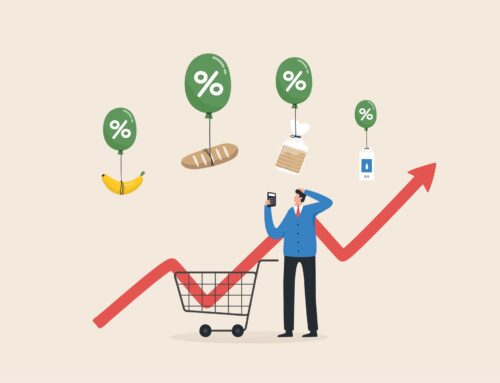
In 1960, a gallon of conventional whole milk was 31 cents, and today it’s $4.21 on average.[1] A few dollars might not seem like much, but that’s a 1,258% increase! Now that we’re seeing high inflation, the buying power of your money – including your retirement savings – could be seriously impacted. When calculating how much money you need to retire, consider what you’re left with after inflation.
The Value of Money Over Time
When you think about the fact that almost everything you buy is increasing in price, inflation is a major concern. The value of your money decreases over time: If you took a $100 bill in 1960 and time-traveled to $1980, it would only have the buying power of $40. And if you time traveled again to 2021, it would only have the buying power of about $11.[2] What will happen over the next 20 years – how much will the value of your retirement savings decrease? After ten years of 7% inflation, $1 million would be worth about half – $508,350.
The Big Picture
Daily life is arguably the most expensive it’s been in 40 years since inflation is at 40-year highs. Inflation can also impact the economy and market, in addition to your wallet. Inflation can hurt purchasing power, which can weigh down economic growth. The last time the inflation rate was over 5%, the U.S. was in the Great Recession.[3] Some economists predict a 1970s-style stagflation in this decade since we also saw higher energy prices and unemployment in 2021.[4] Inflation was as high as 14.5% in 1980.[5] To put it in concrete terms, the buying power of $100 in 1960 now has the buying power of $11.24.[6]
Why Retirees May Need to Worry About Inflation More Than Others
If you’re living off of your savings and your sources of retirement income don’t increase over time, you may need to worry about inflation more than others do. While keeping your money in the market can be one strategy to combat inflation, you may not want to expose your nest egg to much market risk. This makes this period of high inflation and market volatility difficult for those nearing and in retirement.
[1] https://www.ams.usda.gov/sites/default/files/media/RetailMilkPrices.pdf
[2] https://www.buyupside.com/calculators/inflationjan08.htm
[3] https://www.fool.com/investing/2021/08/28/stock-market-crash-likely-5-data-points-of-concern/
[4] https://qz.com/2068772/why-economists-are-talking-about-stagflation/
[5] https://www.federalreservehistory.org/essays/great-inflation
[6] https://westegg.com/inflation/infl.cgi?money=100&first=1960&final=2020
The commentary on this blog reflects the personal opinions, viewpoints, and analyses of BML Wealth Management’s employees providing such comments and should not be regarded as a description of advisory services provided by West Wealth Group, LLC. The views reflected in the commentary are subject to change at any time without notice. Nothing on this blog constitutes investment advice. Any mention of a particular security and related performance data is not a recommendation to buy or sell that security. Investing involves risk, including the potential loss of principal. No investment strategy can guarantee a profit or protect against loss in periods of declining values. Past performance is no guarantee of future returns.
Investment advisory services through West Wealth Group, LLC, an SEC Registered Investment Adviser. BML Wealth Management and West Wealth Group, LLC are affiliated entities. Insurance Services are offered through BML Wealth & Insurance Services, California Insurance License #0M15550.
We do not provide tax or legal advice. All individuals are encouraged to seek guidance from qualified professionals regarding their personal situation. Any references to protection benefits or steady and reliable income streams in this guide refer only to fixed insurance products. They do not refer, in any way, to securities or investment advisory products.






